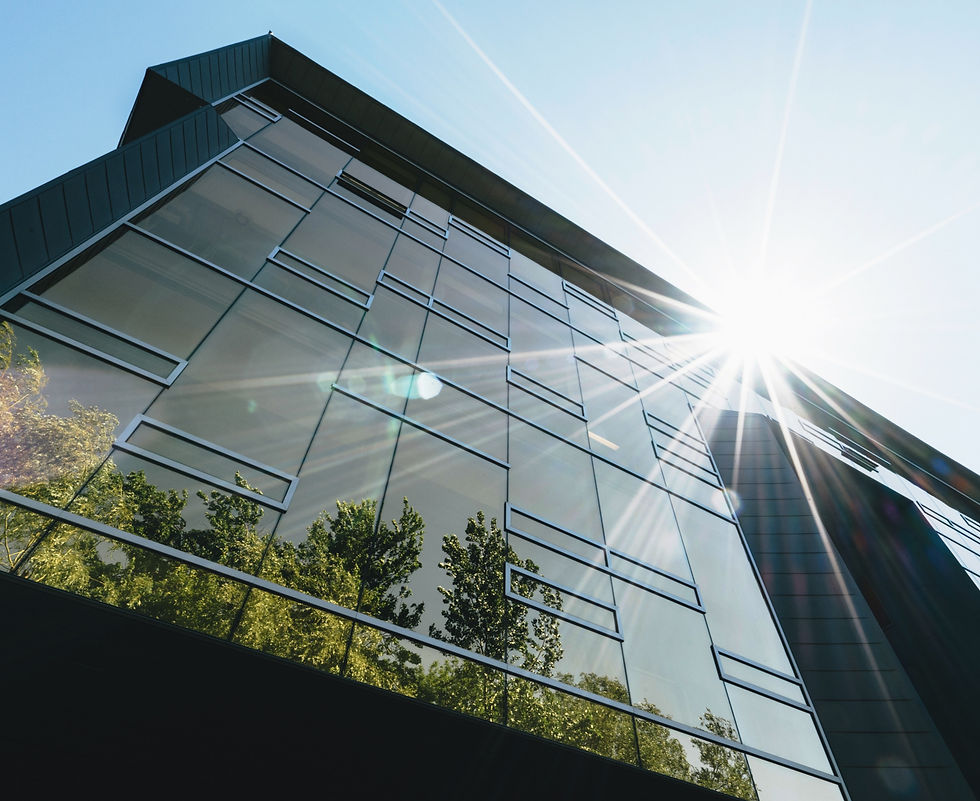Eco Master
- Brooks McKinney, APR
- Nov 20, 2019
- 6 min read
Updated: Jun 3, 2022
As a young girl, Heather DeGrella got her first lesson in sustainability by looking out the window of her parents’ modest, ranch-style home on the outskirts of Nashville, Tenn. Everywhere she looked, she saw new, tiny pine trees growing around the house and throughout the family’s rolling two-acre property.

“When my parents bought their house, it sat in the middle of a lot that had been clear cut (stripped of all its trees) by a developer who was completely insensitive to the environment,” said DeGrella, the sustainable design director for Portland, Ore.-based Opsis Architecture. “My dad immediately went out and bought 100 baby pine trees and planted them all over our yard. I literally grew up in a land restoration project surrounded by nature and a wonderful forest of pine trees.”

Leading Early, Often
Today, DeGrella brings that same passion for the environment and #sustainability to work every day. She oversees and guides the work of multiple teams that plan, design, build and provide post-occupancy evaluation of sustainably-developed facilities throughout the greater Portland region.
#Sustainabledesign involves construction that minimizes negative environmental impacts while promoting the health and comfort of building occupants. It aims to reduce consumption of nonrenewable resources, incorporate environmentally-friendly building materials, and minimize waste.
“I try to get my teams and our clients engaged in thinking about sustainable design as early as possible,” said DeGrella. “The more we can get everyone at the table thinking critically about all the ways the new space will be used, the more successful we’re going to be at delivering a facility that makes its occupants and the Earth happy.”
Finding Her Passion
When DeGrella was growing up, her father, a Nashville police officer with a passion for energy efficiency – he was constantly making energy-related improvements to the family home, she recalls – recognized that his daughter loved art, but was also really good at math.
“I think I was in high school when he planted the seed of me becoming an architect,” said DeGrella. “He started saying things like, ‘Hey, wouldn’t it be cool to be an architect?’”
As an undergrad at the University of North Carolina, Chapel Hill, DeGrella changed her major several times before deciding that she really did want to become an architect. Except UNC did not offer a degree in architecture. So she settled on a major in architectural art history. And graduated Phi Beta Kappa just for good measure.

It wasn’t until DeGrella started graduate school in architecture at the University of Texas, Austin, however, that she realized she could combine all of her passions – art, mathematics and the environment – into one degree program.
At UT Austin, DeGrella not only launched her career in sustainable design – she graduated in 1998 with a Master of Architecture degree – but also met the man who would later help her launch a family. Soon after graduation, DeGrella accepted a job with Lake|Flato, an architectural firm in San Antonio, Texas well known for its work in sustainability.
“I told my husband I wanted to work at this great firm, and that it would only be for two years,” said DeGrella.
Building a Foundation
Those two years in San Antonio turned into 12, as DeGrella immersed herself in the world of sustainability and green building design. At Lake|Flato she worked as a project designer, project manager and construction administrator. But she also found time to help found the Central Texas – Balcones Chapter of the U.S. Green Building Council. And in 2008, she was recognized with a “40 Under 40 Rising Stars” award from the San Antonio Business Journal for her leadership in raising the profile of sustainability among local builders.
12 years in Texas, however, was all the heat that DeGrella’s husband could stand, so they moved back to the Pacific Northwest in 2011.
Challenging the Rules
Today, much of DeGrella’s work for Opsis revolves around K-12 and higher education projects – educational infrastructure, if you will. And much of that work focuses around a collaborative design process called eco-charrettes.
“Eco-charrettes are essentially sustainability workshops,” explains DeGrella. “We use them to generate a design solution for a new building. Our workshops include and reflect not only the ideas of the planners, designers and engineers who will create the space, but also the diverse interests of the people who will be using the space.”

DeGrella’s inclusive design approach also reflects her desire to take advantage of the latest building technology tools. Among her Opsis colleagues, she is known for using these tools to challenge basic “rule of thumb” assumptions about the building design process.
“When we think about how someone will use a space, we have to make basic assumptions based on our experience,” she said. “That’s an okay place to start, but not an okay place to stay. Today we have access to advanced 3-D modeling tools and robust analysis tools. We need to use those tools early in every project to make sure that our initial assumptions are correct.”
Resetting Normal
Besides guiding the thinking of her design teams, DeGrella works to educate her clients about the evolving nature of sustainable design. Many technologies and building materials once considered safe for human exposure are now being pushed aside for cleaner – and often more expensive – alternatives.
“Decarbonization is the new word,” she said. “We now realize that our buildings and the operation of our buildings are responsible for so much of our carbon emissions, which contributes to climate change.”
For Opsis clients, DeGrella added, decarbonization can mean eliminating not only gas-powered appliances, but also the (often) leaky pipelines that deliver that gas. It can also mean replacing many conventional building materials – steel, vinyl (toxic fumes when it is made and when it burns), and even wood – with more sustainable materials.

Trusting Green
DeGrella admits that green building may initially seem more expensive than conventional building, but its long-term benefits are immeasurable.
“If done right, green buildings will pay for themselves in a reasonable amount of time through lower energy costs and lower consumption of natural resources,” she said. More importantly, she adds, a building designed with the needs of its human occupants in mind will produce happier, healthier occupants,
which translates into higher productivity,
fewer sick days, and lower overall medical costs.
Her favorite example of green building is the Opsis-designed Oregon Zoo Education Center (OZEC) in Portland. Designed around the theme “Small Things Matter,” the net-zero energy building features interactive exhibits that emphasize the collective impact of daily individual actions on the health of the planet. OZEC was recognized for its design excellence and environmental performance with a 2010 Committee of the Environment Top Ten award from the American Institute of Architects.
Riding the Dream
DeGrella’s work days begin early in Vancouver, Wash., a 10-mile bike ride across the Columbia River and Willamette River from the Opsis offices near downtown Portland. Breakfast usually includes yogurt, a boiled egg, coffee, and a scan of the morning headlines.

When it comes to transportation, DeGrella describes herself as "multi-modal."
“I usually ride to work at least two days per week, and carpool with a neighbor the other days,” she said. “If it’s raining, I might take my bike on a commuter bus, or ride part way and then take the Max (Portland’s light rail system).”
The most exciting recent addition to her commute, she adds, is an electric bike. The new set of wheels has reduced her commute time and increased the frequency of her bike commutes.
Teaching the Long Game
A typical work day for DeGrella includes meetings in the office with her project teams and, if she’s lucky, an offsite meeting with a design team and client user groups as part of an eco-charrette. But what really gets her creative juices flowing is her work mentoring the next generation of green building designers. She meets on a regular basis with graduate students from the University of Oregon and Portland State University to advise on their research projects in sustainable design.
“Right now, the balance between the professional side and the research projects with students is just about perfect,” she said. “I love being hands on with my design teams, but the work these students are doing is unique and definitely cutting edge.”

As for the future, and the world’s willingness to engage in serious sustainability actions, she draws inspiration and hope not only from the next generation – her newest hero is the Swedish schoolgirl Greta Thunberg – but also from her foundational years in San Antonio.
“The sustainable design community in Central Texas included people from all different firms working together, supporting each other, and sharing resources – something that’s not always done in a profession that can be very competitive,” she reflects. “Having that community to check in with and draw support from was truly a blessing and continues to inspire me today.”
# # #
Did you find this story interesting? If so, please send the link to one of your friends, or visit www.personsofinfrastructure.com/blog to read about more innovative people transforming our nation’s infrastructure. If you’d like to suggest a person or topic for one of my profiles, please send your ideas to me at brooks@personsofinfrastructure.com. Many thanks.

コメント